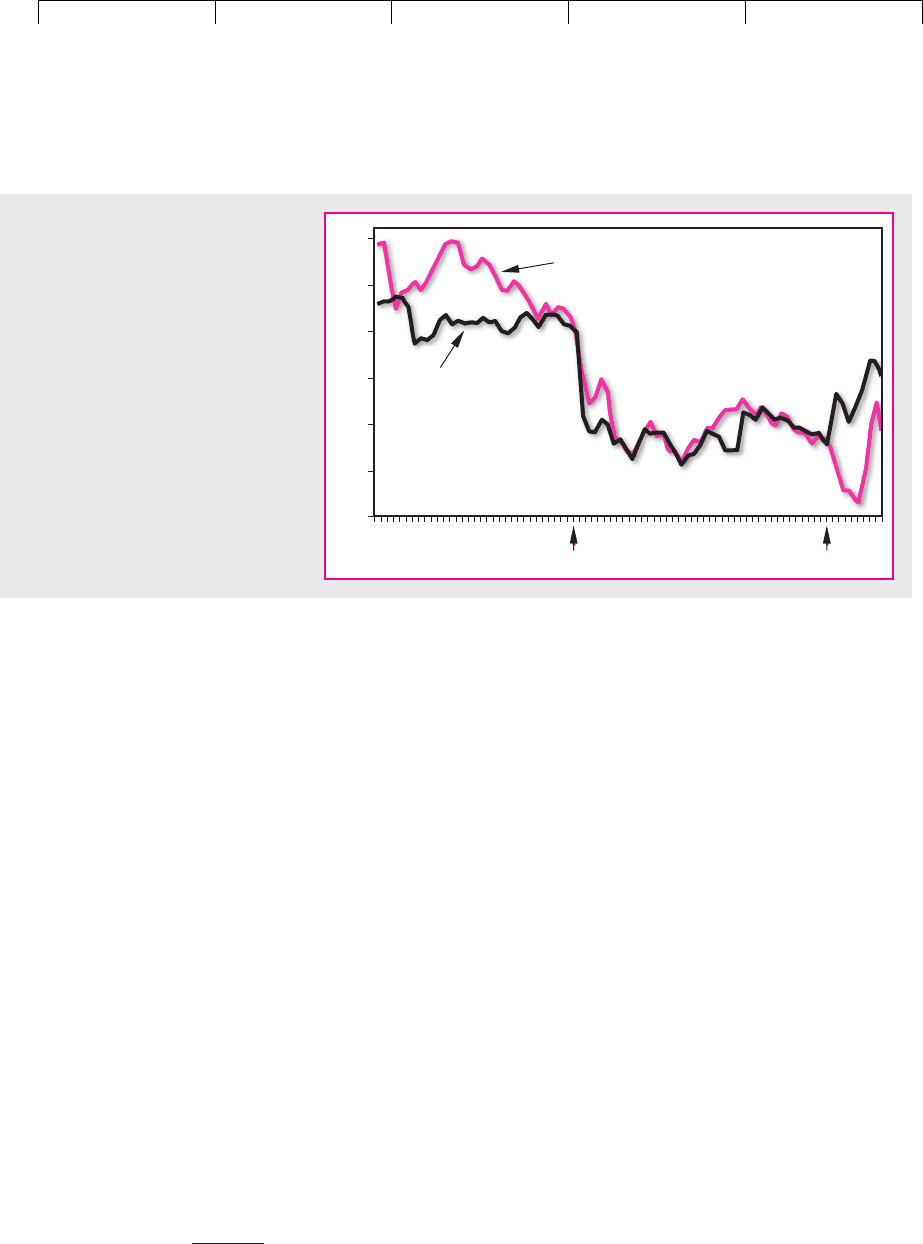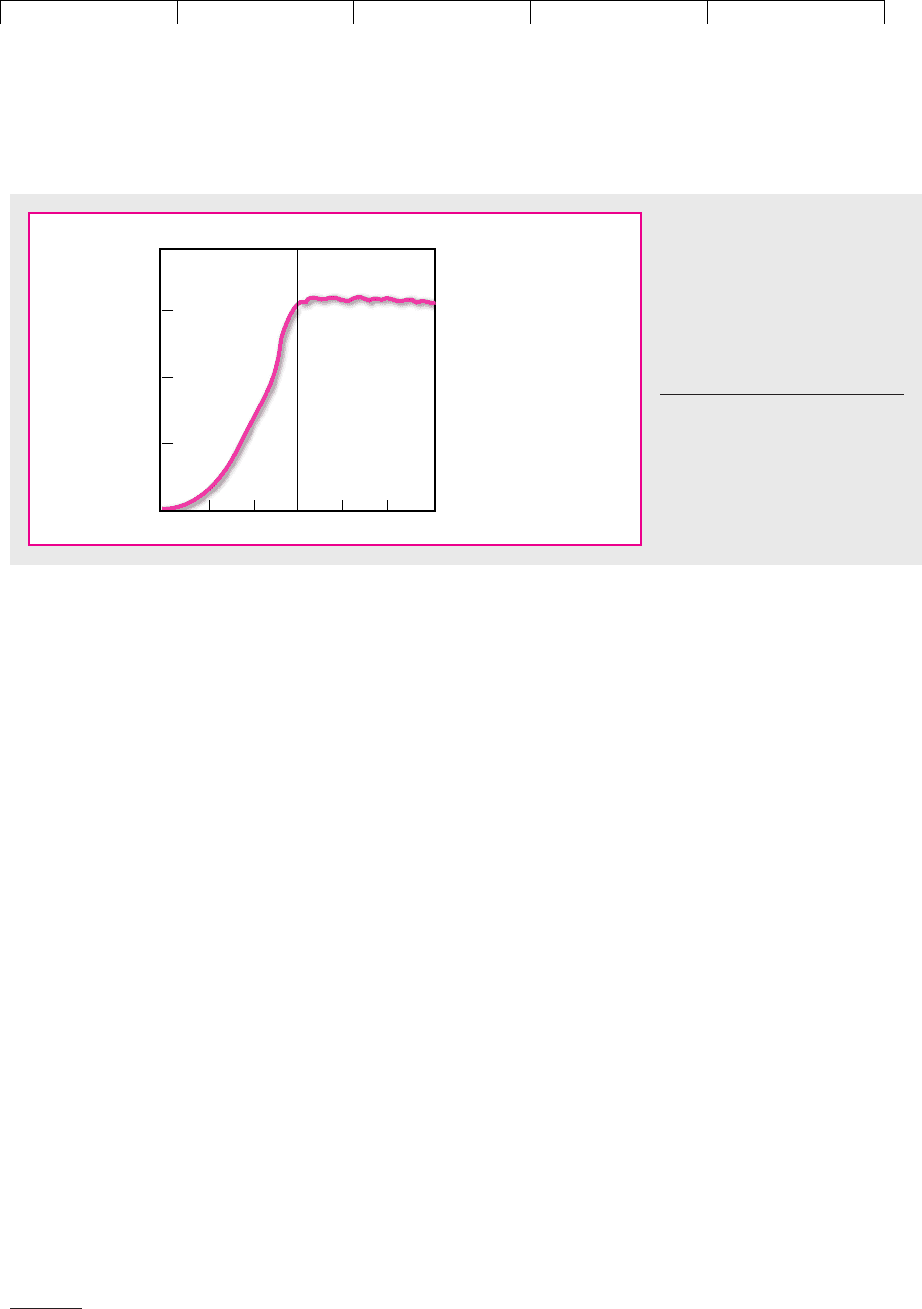Brealey, Myers. Principles of Corporate Finance. 7th edition
Подождите немного. Документ загружается.


Brealey−Meyers:
Principles of Corporate
Finance, Seventh Edition
IV. Financial Decisions and
Market Efficiency
13. Corporate Financing
and the Six Lessons of
Market Efficiency
© The McGraw−Hill
Companies, 2003
human nature that can tell us when investors will overreact and when they will un-
derreact, we are just as well off with the efficient-market theory which tells us that
overreactions and underreactions are equally likely.
19
There is another question that needs answering before we accept a behavioral
bias as an explanation of an anomaly. It may well be true that many of us have a
tendency to over- or underreact to recent events. However, hard-headed profes-
sional investors are constantly on the lookout for possible biases that may be a
source of future profits.
20
So it is not enough to refer to irrationality on the part of
individual investors; we also need to explain why professional investors have not
competed away the apparent profit opportunities that such irrationality offers. The
evidence on the performance of professionally managed portfolios suggests that
many of these anomalies were not so easy to predict.
Professional Investors, Irrational Exuberance, and the Dot.com Bubble
Investors in technology stocks in the 1990s saw an extraordinary run-up in the
value of their holdings. The Nasdaq Composite Index, which has a heavy weight-
ing in high-tech stocks, rose 580 percent from the start of 1995 to its high in March
2000. Then even more rapidly than it began, the boom ended. By November 2001
the Nasdaq index had fallen 64 percent.
Some of the largest price gains and losses were experienced by the new
“dot.com stocks.” For example, Yahoo! shares, which began trading in April 1996,
appreciated by 1,400 percent in just four years. At this point Yahoo! stock was val-
ued at $124 billion, more than that of GM, Heinz, and Boeing combined. It was not,
however, to last; just over a year later Yahoo!’s market capitalization was little more
than $6 billion.
What caused the boom in high-tech stocks? Alan Greenspan, chairman of the Fed-
eral Reserve, attributed the run-up in prices to “irrational exuberance,” a view that
was shared by Professor Robert Shiller from Yale. In his book Irrational Exuberance
21
Shiller argued that, as the bull market developed, it generated optimism about the
future and stimulated demand for shares.
22
Moreover, as investors racked up prof-
its on their stocks, they became even more confident in their opinions.
But this brings us back to the $64,000 question. If Shiller was right and individ-
ual investors were carried away by irrational optimism, why didn’t smart profes-
sional investors step in, sell high-tech stocks, and force their prices down to fair
value? Were the pros also carried away on the same wave of euphoria? Or were
they rationally reluctant to undertake more than a limited amount of selling if they
could not be sure where and when the boom would end?
360 PART IV
Financing Decisions and Market Efficiency
19
This point is made in E. F. Fama, “Market Efficiency, Long-Term Returns, and Behavioral Finance,”
Journal of Financial Economics 49 (September 1998), pp. 283–306. One paper that does seek to model why
investors may both underreact and overreact is N. Barberis, A. Shleifer, and R. Vishny, “A Model of In-
vestor Sentiment,” Journal of Financial Economics 49 (September 1998), pp. 307–343.
20
Many financial institutions employ behavioral finance specialists to advise them on these biases.
21
See R. J. Shiller, Irrational Exuberance, Broadway Books, 2001. Shiller also discusses behavioral expla-
nations for the boom in R. J. Shiller, “Bubbles, Human Judgment, and Expert Opinion,” Cowles Foun-
dation Discussion Paper No. 1303, Cowles Foundation for Research in Economics, Yale University, New
Haven, CT, May 2001.
22
Some economists believe that the market price is prone to “bubbles”—situations in which price grows
faster than fundamental value, but investors don’t sell because they expect prices to keep rising. Of
course, all such bubbles pop eventually, but they can in theory be self-sustaining for a while. The Jour-
nal of Economic Perspectives 4 (Spring 1990) contains several nontechnical articles on bubbles.

Brealey−Meyers:
Principles of Corporate
Finance, Seventh Edition
IV. Financial Decisions and
Market Efficiency
13. Corporate Financing
and the Six Lessons of
Market Efficiency
© The McGraw−Hill
Companies, 2003
The Crash of 1987 and Relative Efficiency
On Monday, October 19, 1987, the Dow Jones Industrial Average (the Dow) fell 23
percent in one day. Immediately after the crash, everybody started to ask two ques-
tions: Who were the guilty parties? and Do prices reflect fundamental values?
As in most murder mysteries, the immediate suspects are not the ones “who done
it.” The first group of suspects included index arbitrageurs, who trade back and forth
between index futures
23
and the stocks comprising the market index, taking advan-
tage of any price discrepancies. On Black Monday futures fell first and fastest be-
cause investors found it easier to bail out of the stock market by way of futures than
by selling individual stocks. This pushed the futures price below the stock market in-
dex.
24
The arbitrageurs tried to make money by selling stocks and buying futures,
but they found it difficult to get up-to-date quotes on the stocks they wished to trade.
Thus the futures and stock markets were for a time disconnected. Arbitrageurs con-
tributed to the trading volume that swamped the New York Stock Exchange, but
they did not cause the crash; they were the messengers who tried to transmit the sell-
ing pressure in the futures market back to the exchange.
The second suspects were large institutional investors who were trying to im-
plement portfolio insurance schemes. Portfolio insurance aims to put a floor on the
value of an equity portfolio by progressively selling stocks and buying safe, short-
term debt securities as stock prices fall. Thus the selling pressure that drove prices
down on Black Monday led portfolio insurers to sell still more. One institutional
investor on October 19 sold stocks and futures totalling $1.7 billion. The immedi-
ate cause of the price fall on Black Monday may have been a herd of elephants all
trying to leave by the same exit.
Perhaps some large portfolio insurers can be convicted of disorderly conduct,
but why did stocks fall worldwide,
25
when portfolio insurance was significant
only in the United States? Moreover, if sales were triggered mainly by portfolio
insurance or trading tactics, they should have conveyed little fundamental in-
formation, and prices should have bounced back after Black Monday’s confusion
had dissipated.
So why did prices fall so sharply? There was no obvious, new fundamental in-
formation to justify such a sharp and widespread decline in share values. For this
reason, the idea that the market price is the best estimate of intrinsic value seems
less compelling than before the crash. It appears that either prices were irrationally
high before Black Monday or irrationally low afterward. Could the theory of effi-
cient markets be another casualty of the crash?
The events of October 1987 remind us how exceptionally difficult it is to value
common stocks. For example, imagine that in November 2001 you wanted to
check whether common stocks were fairly valued. At least as a first stab you might
use the constant-growth formula that we introduced in Chapter 4. The annual ex-
pected dividend on the Standard and Poor’s Composite Index was about 18.7.
CHAPTER 13
Corporate Financing and the Six Lessons of Market Efficiency 361
23
An index future provides a way of trading in the stock market as a whole. It is a contract that pays in-
vestors the value of the stocks in the index at a specified future date. We discuss futures in Chapter 27.
24
That is, sellers pushed the futures prices below their proper relation to the index (again, see
Chapter 27). The proper relation is not exact equality.
25
Some countries experienced even larger falls than the United States. For example, prices fell by 46 per-
cent in Hong Kong, 42 percent in Australia, and 35 percent in Mexico. For a discussion of the world-
wide nature of the crash, see R. Roll, “The International Crash of October 1987,” in R. Kamphuis (ed.),
Black Monday and the Future of Financial Markets, Richard D. Irwin, Inc., Homewood, IL, 1989.

Brealey−Meyers:
Principles of Corporate
Finance, Seventh Edition
IV. Financial Decisions and
Market Efficiency
13. Corporate Financing
and the Six Lessons of
Market Efficiency
© The McGraw−Hill
Companies, 2003
Suppose this dividend was expected to grow at a steady rate of 10 percent a year
and investors required an annual return of 11.7 percent from common stocks. The
constant growth formula gives a value for the index of
which was roughly the actual level of the index in mid-November 2001. But how
confident could you be about any of these figures? Perhaps the likely dividend
growth was only 9.5 percent per year. This would produce a 23 percent downward
revision in your estimate of the right level of the index, from 1,100 to 850!
In other words, a price drop like Black Monday’s could have occurred if investors
had become just 0.5 percentage point less optimistic about future dividend growth.
The extreme difficulty of valuing common stocks from scratch has two impor-
tant consequences. First, investors almost always price a common stock relative to
yesterday’s price or relative to today’s price of comparable securities. In other
words, they generally take yesterday’s price as correct, adjusting upward or down-
ward on the basis of today’s information. If information arrives smoothly, then as
time passes, investors become more and more confident that today’s price level is
correct. However, when investors lose confidence in the benchmark of yesterday’s
price, there may be a period of confused trading and volatile prices before a new
benchmark is established.
Second, the hypothesis that stock price always equals intrinsic value is nearly im-
possible to test, because it is so difficult to calculate intrinsic value without refer-
ring to prices. Thus the crash did not conclusively disprove the hypothesis, but
many people find it less plausible.
However, the crash does not undermine the evidence for market efficiency with
respect to relative prices. Take, for example, Hershey stock, which sold for $66 in
November 2001. Could we prove that true intrinsic value is $66? No, but we could
be more confident that the price of Hershey should be roughly double that of
Smucker ($33) since Hershey’s earnings per share and dividend were about twice
those of Smucker and the two shares had similar growth prospects. Moreover, if ei-
ther company announced unexpectedly higher earnings, we could be quite confi-
dent that its share price would respond instantly and without bias. In other words,
the subsequent price would be set correctly relative to the prior price. The most im-
portant lessons of market efficiency for the corporate financial manager are con-
cerned with relative efficiency.
Market Anomalies and the Financial Manager
The financial manager needs to be confident that, when the firm issues new secu-
rities, it can do so at a fair price. There are two reasons that this may not be the case.
First, the strong form of the efficient-market hypothesis may not be 100 percent
true, so that the financial manager may have information that other investors do
not have. Alternatively, investors may have the same information as management,
but be slow to react to it. For example, we described above some evidence that new
issues of stock tend to be followed by a prolonged period of low stock returns.
You sometimes hear managers say something along the following lines:
PV1index2⫽
DIV
r ⫺ g
⫽
18.7
.117 ⫺ .095
⫽ 850
PV1index2⫽
DIV
r ⫺ g
⫽
18.7
.117 ⫺ .10
⫽ 1,100
362 PART IV Financing Decisions and Market Efficiency

Brealey−Meyers:
Principles of Corporate
Finance, Seventh Edition
IV. Financial Decisions and
Market Efficiency
13. Corporate Financing
and the Six Lessons of
Market Efficiency
© The McGraw−Hill
Companies, 2003
Great! Our stock is clearly overpriced. This means we can raise capital cheaply and
invest in Project X. Our high stock price gives us a big advantage over our com-
petitors who could not possibly justify investing in Project X.
But that doesn’t make sense. If your stock is truly overpriced, you can help your
current shareholders by selling additional stock and using the cash to invest in
other capital market securities. But you should never issue stock to invest in a proj-
ect that offers a lower rate of return than you could earn elsewhere in the capital
market. Such a project would have a negative NPV. You can always do better than
investing in a negative-NPV project: Your company can go out and buy common
stocks. In an efficient market, such purchases are always zero NPV.
What about the reverse? Suppose you know that your stock is underpriced. In
that case, it certainly would not help your current shareholders to sell additional
“cheap” stock to invest in other fairly priced stocks. If your stock is sufficiently un-
derpriced, it may even pay to forego an opportunity to invest in a positive-NPV
project rather than to allow new investors to buy into your firm at a low price. Fi-
nancial managers who believe that their firm’s stock is underpriced may be justi-
fiably reluctant to issue more stock, but they may instead be able to finance their
investment program by an issue of debt. In this case the market inefficiency would
affect the firm’s choice of financing but not its real investment decisions. In Chap-
ter 15 we will have more to say about the financing choice when managers believe
their stock is mispriced.
CHAPTER 13
Corporate Financing and the Six Lessons of Market Efficiency 363
13.4 THE SIX LESSONS OF MARKET EFFICIENCY
Sorting out the puzzles will take time, but we believe that there is now widespread
agreement that capital markets function sufficiently well that opportunities for
easy profits are rare. So nowadays when economists come across instances where
market prices apparently don’t make sense, they don’t throw the efficient-market
hypothesis onto the economic garbage heap. Instead, they think carefully about
whether there is some missing ingredient that their theories ignore.
We suggest therefore that financial managers should assume, at least as a start-
ing point, that security prices are fair and that it is very difficult to outguess the
market. This has some important implications for the financial manager.
Lesson 1: Markets Have No Memory
The weak form of the efficient-market hypothesis states that the sequence of past
price changes contains no information about future changes. Economists express
the same idea more concisely when they say that the market has no memory. Some-
times financial managers seem to act as if this were not the case. For example, stud-
ies by Taggart and others in the United States and by Marsh in the United Kingdom
show that managers generally favor equity rather than debt financing after an ab-
normal price rise.
26
The idea is to catch the market while it is high. Similarly, they
26
R. A. Taggart, “A Model of Corporate Financing Decisions,” Journal of Finance 32 (December 1977),
pp. 1467–1484; P. Asquith and D. W. Mullins, Jr., “Equity Issues and Offering Dilution,” Journal of Fi-
nancial Economics 15 (January–February 1986), pp. 16–89; P. R. Marsh, “The Choice between Debt and
Equity: An Empirical Study,” Journal of Finance 37 (March 1982), pp. 121–144.

Brealey−Meyers:
Principles of Corporate
Finance, Seventh Edition
IV. Financial Decisions and
Market Efficiency
13. Corporate Financing
and the Six Lessons of
Market Efficiency
© The McGraw−Hill
Companies, 2003
are often reluctant to issue stock after a fall in price. They are inclined to wait for a
rebound. But we know that the market has no memory and the cycles that financial
managers seem to rely on do not exist.
27
Sometimes a financial manager will have inside information indicating that the
firm’s stock is overpriced or underpriced. Suppose, for example, that there is some
good news which the market does not know but you do. The stock price will rise
sharply when the news is revealed. Therefore, if the company sold shares at the
current price, it would be offering a bargain to new investors at the expense of pres-
ent stockholders.
Naturally, managers are reluctant to sell new shares when they have favorable
inside information. But such information has nothing to do with the history of the
stock price. Your firm’s stock could be selling at half its price of a year ago, and yet
you could have special information suggesting that it is still grossly overvalued. Or
it may be undervalued at twice last year’s price.
Lesson 2: Trust Market Prices
In an efficient market you can trust prices, for they impound all available infor-
mation about the value of each security. This means that in an efficient market,
there is no way for most investors to achieve consistently superior rates of return.
To do so, you not only need to know more than anyone else, but you also need to
know more than everyone else. This message is important for the financial manager
who is responsible for the firm’s exchange-rate policy or for its purchases and sales
of debt. If you operate on the basis that you are smarter than others at predicting
currency changes or interest-rate moves, you will trade a consistent financial pol-
icy for an elusive will-o’-the-wisp.
The company’s assets may also be directly affected by management’s faith in
its investment skills. For example, one company may purchase another simply
because its management thinks that the stock is undervalued. On approximately
half the occasions the stock of the acquired firm will with hindsight turn out to
be undervalued. But on the other half it will be overvalued. On average the value
will be correct, so the acquiring company is playing a fair game except for the
costs of the acquisition.
Example—Orange County In December 1994, Orange County, one of the wealthi-
est counties in the United States, announced that it had lost $1.7 billion on its invest-
ment portfolio. The losses arose because the county treasurer, Robert Citron, had
raised large short-term loans which he then used to bet on a rise in long-term bond
prices.
28
The bonds that the county bought were backed by government-guaranteed
mortgage loans. However, some of them were of an unusual type known as reverse
364 PART IV
Financing Decisions and Market Efficiency
27
If high stock prices signal expanded investment opportunities and the need to finance these new in-
vestments, we would expect to see firms raise more money in total when stock prices are historically
high. But this does not explain why firms prefer to raise the extra cash at these times by an issue of eq-
uity rather than debt.
28
Orange County borrowed money in the following way. Suppose it bought bond A and then sold it to
a bank with a promise to buy it back at a slightly higher price. The cash from this sale was then invested
in bond B. If bond prices fell, the county lost twice over: Its investment in bond B was worth less than
the purchase price, and it was obliged to repurchase bond A for more than the bond was now worth.
The sale and repurchase of bond A is known as a reverse repurchase agreement, or reverse “repo.” We
describe repos in Chapter 31.

Brealey−Meyers:
Principles of Corporate
Finance, Seventh Edition
IV. Financial Decisions and
Market Efficiency
13. Corporate Financing
and the Six Lessons of
Market Efficiency
© The McGraw−Hill
Companies, 2003
floaters, which means that as interest rates rise, the interest payment on each bond is
reduced, and vice versa.
Reverse floaters are riskier than normal bonds. When interest rates rise, prices
of all bonds fall, but prices of reverse floaters suffer a double whammy because the
interest rate payments decline as the discount rate rises. Thus Robert Citron’s pol-
icy of borrowing to invest in reverse floaters ensured that when, contrary to his
forecast, interest rates subsequently rose, the fund suffered huge losses.
Like Robert Citron, financial managers sometimes take large bets because they
believe that they can spot the direction of interest rates, stock prices, or exchange
rates, and sometimes their employers may encourage them to speculate.
29
We do
not mean to imply that such speculation always results in losses, as in Orange
County’s case, for in an efficient market speculators win as often as they lose.
30
But
corporate and municipal treasurers would do better to trust market prices rather
than incur large risks in the quest for trading profits.
Lesson 3: Read the Entrails
If the market is efficient, prices impound all available information. Therefore, if we can
only learn to read the entrails, security prices can tell us a lot about the future. For ex-
ample, in Chapter 29 we will show how information in a company’s financial state-
ments can help the financial manager to estimate the probability of bankruptcy. But the
market’s assessment of the company’s securities can also provide important informa-
tion about the firm’s prospects. Thus, if the company’s bonds are offering a much
higher yield than the average, you can deduce that the firm is probably in trouble.
Here is another example: Suppose that investors are confident that interest rates
are set to rise over the next year. In that case, they will prefer to wait before they
make long-term loans, and any firm that wants to borrow long-term money today
will have to offer the inducement of a higher rate of interest. In other words, the
long-term rate of interest will have to be higher than the one-year rate. Differences
between the long-term interest rate and the short-term rate tell you something
about what investors expect to happen to short-term rates in the future.
31
Example—Hewlett Packard Proposes to Merge with Compaq On September 3,
2001, two computer companies, Hewlett Packard and Compaq, revealed plans to
merge. Announcing the proposal, Carly Fiorina, the chief executive of Hewlett
Packard, stated: “This combination vaults us into a leadership role” and creates
“substantial shareowner value through significant cost structure improvements
and access to new growth opportunities.” But investors and analysts gave the pro-
posal a big thumbs-down. Figure 13.8 shows that over the following two days the
shares of Hewlett Packard underperformed the market by 21 percent, while Com-
paq shares underperformed by 16 percent. Investors, it seems, believed that the
merger had a negative net present value of $13 billion. When on November 6 the
Hewlett family announced that it would vote against the proposal, investors took
CHAPTER 13
Corporate Financing and the Six Lessons of Market Efficiency 365
29
We don’t know why Robert Citron gambled with Orange County’s money, but he was under pressure
to make up for a shortfall in tax revenues.
30
Watch out for the speculators who are making very large profits; they are almost certainly taking cor-
respondingly large risks.
31
We will discuss the relationship between short-term and long-term interest rates in Chapter 24. No-
tice, however, that in an efficient market the difference between the prices of any short-term and long-
term contracts always says something about how participants expect prices to move.

Brealey−Meyers:
Principles of Corporate
Finance, Seventh Edition
IV. Financial Decisions and
Market Efficiency
13. Corporate Financing
and the Six Lessons of
Market Efficiency
© The McGraw−Hill
Companies, 2003
heart, and the next day Hewlett Packard shares gained 16 percent.
32
We do not
wish to imply that investor concerns about the merger were justified, for manage-
ment may have had important information that investors lacked. Our point is sim-
ply that the price reaction of the two stocks provided a potentially valuable sum-
mary of investor opinion about the effect of the merger on firm value.
Lesson 4: There Are No Financial Illusions
In an efficient market there are no financial illusions. Investors are unromantically
concerned with the firm’s cash flows and the portion of those cash flows to which
they are entitled.
Example—Stock Dividends and Splits We can illustrate our fourth lesson by look-
ing at the effect of stock dividends and splits. Every year hundreds of companies in-
crease the number of shares outstanding either by subdividing the existing shares or
by distributing more shares as dividends. This does not affect the company’s future
cash flows or the proportion of these cash flows attributable to each shareholder. For
example, suppose the stock of Chaste Manhattan is selling for $210 per share. A 3-for-
1 stock split would replace each outstanding share with three new shares. Chaste
would probably arrange this by printing two new shares for each original share and
distributing the new shares to its stockholders as a “free gift.” After the split we would
expect each share to sell for 210/3 ⫽ $70. Dividends per share, earnings per share, and
all other per-share variables would be one-third their previous levels.
Figure 13.9 summarizes the results of a classic study of stock splits during the
years 1926 to 1960.
33
It shows the cumulative abnormal performance of stocks
366 PART IV
Financing Decisions and Market Efficiency
1.2
1.1
1
0.9
Hewlett-Packard
0.8
0.7
0.6
Compaq
September 3
November 6
FIGURE 13.8
Cumulative abnormal returns on
Hewlett Packard and Compaq stocks
during four-month period surrounding
the announcement on September 3,
2001, of a proposed merger. Hewlett
Packard stock recovered after the
Hewlett family announced on
November 6 that it would vote against
the merger.
32
The stock of Compaq, which was thought to be less badly affected by the merger, fell on the news, be-
fore also rising.
33
See E. F. Fama, L. Fisher, M. Jensen, and R. Roll, “The Adjustment of Stock Prices to New Informa-
tion,” International Economic Review 10 (February 1969), pp. 1–21. Later researchers have discovered that
shareholders make abnormal gains both when the split or stock dividend is announced and when it
takes place. Nobody has offered a convincing explanation for the latter phenomenon. See, for example,
M. S. Grinblatt, R. W. Masulis, and S. Titman, “The Valuation Effects of Stock Splits and Stock Divi-
dends,” Journal of Financial Economics 13 (December 1984), pp. 461–490.

Brealey−Meyers:
Principles of Corporate
Finance, Seventh Edition
IV. Financial Decisions and
Market Efficiency
13. Corporate Financing
and the Six Lessons of
Market Efficiency
© The McGraw−Hill
Companies, 2003
around the time of the split after adjustment for the increase in the number of
shares.
34
Notice the rise in price before the split. The announcement of the split
would have occurred in the last month or two of this period. That means the de-
cision to split is both the consequence of a rise in price and the cause of a further
rise. It looks as if shareholders are not as hard-headed as we have been making
out. They do seem to care about the form as well as the substance. However, dur-
ing the subsequent year two-thirds of the splitting companies announced
above-average increases in cash dividends. Normally such an announcement
would cause an unusual rise in the stock price, but in the case of the splitting
companies there was no such occurrence at any time after the split. The appar-
ent explanation is that the split was accompanied by an explicit or implicit
promise of a dividend increase and the rise in price at the time of the split had
nothing to do with a predilection for splits as such but with the information that
it was thought to convey.
This behavior does not imply that investors like the dividend increases for their
own sake, for companies that split their stocks appear to be unusually successful in
other ways. For example, Asquith, Healy, and Palepu found that stock splits are fre-
quently preceded by sharp increases in earnings.
35
Such earnings increases are very
often transitory, and investors rightly regard them with suspicion. However, the stock
split appears to provide investors with an assurance that in this case the rise in earn-
ings is indeed permanent.
Example—Accounting Changes There are other occasions on which managers
seem to assume that investors suffer from financial illusion. For example, some
firms devote considerable ingenuity to the task of manipulating earnings reported
to stockholders. This is done by “creative accounting,” that is, by choosing ac-
counting methods that stabilize and increase reported earnings. Presumably firms
CHAPTER 13
Corporate Financing and the Six Lessons of Market Efficiency 367
Change in stock price, percent
Months relative to split
+33
+22
+11
0
+20
–20 0
FIGURE 13.9
Cumulative abnormal returns at
the time of a stock split. (Returns
are adjusted for the increase in
the number of shares.) Notice the
rise before the split and the
absence of abnormal changes
after the split.
Source: E. Fama, L. Fisher, M. Jensen,
and R. Roll, “The Adjustment of Stock
Prices to New Information,” Interna-
tional Economic Review 10 (February
1969), fig. 2b, p. 13.
34
By this we mean that the study looked at the change in the shareholders’ wealth. A decline in the price
of Chaste Manhattan stock from $210 to $70 at the time of the split would not affect shareholders’
wealth.
35
See P. Asquith, P. Healy, and K. Palepu, “Earnings and Stock Splits,” Accounting Review 64 (July 1989),
pp. 387–403.

Brealey−Meyers:
Principles of Corporate
Finance, Seventh Edition
IV. Financial Decisions and
Market Efficiency
13. Corporate Financing
and the Six Lessons of
Market Efficiency
© The McGraw−Hill
Companies, 2003
go to this trouble because management believes that stockholders take the figures
at face value.
36
One way that companies can affect their reported earnings is through the way
that they cost the goods taken out of inventory. Companies can choose between
two methods. Under the FIFO (first-in, first-out) method, the firm deducts the cost
of the first goods to have been placed in inventory. Under the LIFO (last-in, first-
out) method companies deduct the cost of the latest goods to arrive in the ware-
house. When inflation is high, the cost of the goods that were bought first is likely
to be lower than the cost of those that were bought last. So earnings calculated un-
der FIFO appear higher than those calculated under LIFO.
Now, if it were just a matter of presentation, there would be no harm in switching
from LIFO to FIFO. But the IRS insists that the same method that is used to report to
shareholders also be used to calculate the firm’s taxes. So the lower immediate tax
payments from using the LIFO method also bring lower apparent earnings.
If markets are efficient, investors should welcome a change to LIFO accounting,
even though it reduces earnings. Biddle and Lindahl, who studied the matter, con-
cluded that this is exactly what happens, so that the move to LIFO is associated
with an abnormal rise in the stock price.
37
It seems that shareholders look behind
the figures and focus on the amount of the tax savings.
Lesson 5: The Do-It-Yourself Alternative
In an efficient market investors will not pay others for what they can do equally
well themselves. As we shall see, many of the controversies in corporate financing
center on how well individuals can replicate corporate financial decisions. For ex-
ample, companies often justify mergers on the grounds that they produce a more
diversified and hence more stable firm. But if investors can hold the stocks of both
companies why should they thank the companies for diversifying? It is much eas-
ier and cheaper for them to diversify than it is for the firm.
The financial manager needs to ask the same question when considering
whether it is better to issue debt or common stock. If the firm issues debt, it will
create financial leverage. As a result, the stock will be more risky and it will offer a
higher expected return. But stockholders can obtain financial leverage without the
firm’s issuing debt; they can borrow on their own accounts. The problem for the fi-
nancial manager is, therefore, to decide whether the company can issue debt more
cheaply than the individual shareholder.
Lesson 6: Seen One Stock, Seen Them All
The elasticity of demand for any article measures the percentage change in the quan-
tity demanded for each percentage addition to the price. If the article has close sub-
stitutes, the elasticity will be strongly negative; if not, it will be near zero. For exam-
ple, coffee, which is a staple commodity, has a demand elasticity of about ⫺.2. This
means that a 5 percent increase in the price of coffee changes sales by ⫺.2 ⫻ .05 ⫽⫺.01;
in other words, it reduces demand by only 1 percent. Consumers are likely to regard
368 PART IV
Financing Decisions and Market Efficiency
36
For a discussion of the evidence that investors are not fooled by earnings manipulation, see R. Watts,
“Does It Pay to Manipulate EPS?” in J. M. Stern and D. H. Chew, Jr. (eds.), The Revolution in Corporate
Finance, Oxford, Basil Blackwell, 1986.
37
G. C. Biddle and F. W. Lindahl, “Stock Price Reactions to LIFO Adoptions: The Association between
Excess Returns and LIFO Tax Savings,” Journal of Accounting Research 20 (Autumn 1982, Part 2),
pp. 551–588.

Brealey−Meyers:
Principles of Corporate
Finance, Seventh Edition
IV. Financial Decisions and
Market Efficiency
13. Corporate Financing
and the Six Lessons of
Market Efficiency
© The McGraw−Hill
Companies, 2003
different brands of coffee as much closer substitutes for each other. Therefore, the de-
mand elasticity for a particular brand could be in the region of, say, ⫺2.0. A 5 percent
increase in the price of Maxwell House relative to that of Folgers would in this case
reduce demand by 10 percent.
Investors don’t buy a stock for its unique qualities; they buy it because it offers
the prospect of a fair return for its risk. This means that stocks should be like very
similar brands of coffee, almost perfect substitutes. Therefore, the demand for a
company’s stock should be highly elastic. If its prospective return is too low rela-
tive to its risk, nobody will want to hold that stock. If the reverse is true, everybody
will scramble to buy.
Suppose that you want to sell a large block of stock. Since demand is elastic, you
naturally conclude that you need only to cut the offering price very slightly to sell
your stock. Unfortunately, that doesn’t necessarily follow. When you come to sell
your stock, other investors may suspect that you want to get rid of it because you
know something they don’t. Therefore, they will revise their assessment of the
stock’s value downward. Demand is still elastic, but the whole demand curve
moves down. Elastic demand does not imply that stock prices never change when
a large sale or purchase occurs; it does imply that you can sell large blocks of stock
at close to the market price as long as you can convince other investors that you have no
private information.
Here is one case that supports this view: In June 1977 the Bank of England of-
fered its holding of BP shares for sale at 845 pence each. The bank owned nearly
67 million shares of BP, so the total value of the holding was £564 million, or about
$970 million. It was a huge sum to ask the public to find.
Anyone who wished to apply for BP stock had nearly two weeks within which
to do so. Just before the Bank’s announcement the price of BP stock was 912 pence.
Over the next two weeks the price drifted down to 898 pence, largely in line with
the British equity market. Therefore, by the final application date, the discount be-
ing offered by the Bank was only 6 percent. In return for this discount, any appli-
cant had to raise the necessary cash, taking the risk that the price of BP would de-
cline before the result of the application was known, and had to pass over to the
Bank of England the next dividend on BP.
If Maxwell House coffee is offered at a discount of 6 percent, the demand is un-
likely to be overwhelming. But the discount on BP stock was enough to bring in
applications for $4.6 billion worth of stock, 4.7 times the amount on offer.
We admit that this case was unusual in some respects, but an important study
by Myron Scholes of a large sample of secondary offerings confirmed the ability of
the market to absorb blocks of stock. The average effect of the offerings was a slight
reduction in the stock price, but the decline was almost independent of the amount
offered. Scholes’s estimate of the demand elasticity for a company’s stock was
⫺3,000. Of course, this figure was not meant to be precise, and some researchers
have argued that demand is not as elastic as Scholes’s study suggests.
38
However,
there seems to be widespread agreement with the general point that you can sell
large quantities of stock at close to the market price as long as other investors do
not deduce that you have some private information.
CHAPTER 13
Corporate Financing and the Six Lessons of Market Efficiency 369
38
For example, see W. H. Mikkelson and M. M. Partch, “Stock Price Effects and Costs of Secondary Dis-
tributions,” Journal of Financial Economics 14 (June 1985), pp. 165–194. Scholes’s study is M. S. Scholes,
“The Market for Securities: Substitution versus Price Pressure and the Effects of Information on Share
Prices,” Journal of Business 45 (April 1972), pp. 179–211.
